Optimization Research on Burner Arrangement of Landfill Leachate Concentrate Incinerator Based on “3T+E” Principle
Abstract
:1. Introduction
2. Methods
2.1. Physical Model
2.2. Mathematical Model
- (1)
- Continuity equation:
- (2)
- Momentum equation:
- (3)
- Energy equation:
- (4)
- Turbulence equation:
2.3. Discretization Method and Boundary Conditions
3. Results and Discussion
3.1. Combustion Characteristics of Landfill Leachate under Different Burner Arrangements
3.2. Influence of Nozzle Arrangement Height on Incineration Process of Landfill Leachate Concentrate
4. Conclusions
- (1)
- The symmetrical arrangement of burners is more conducive to the combustion of landfill leachate in the incinerator. For the three arrangements of burners (symmetrical arrangement of reverse swirl, symmetrical arrangement of same direction swirl, staggered arrangement of same direction flow), the outlet temperatures of flue gas are 1152.69 K, 1153.20 K, 1157.87 K, respectively, which are greater than 1123.15 K, meeting the temperature requirements in “3T+E” principle. However, only when the burners are symmetrically arranged, the residence time of the flue gas in the second combustion chamber can exceed 2 s, which meets the requirements of “3T+E” principle, so only the layout of burners should be symmetrical.
- (2)
- When the nozzle arrangement height is 0.9–0.8 m, it is more conducive to the combustion of landfill leachate. Only when the nozzle arrangement height is slightly higher than the center line of a combustion chamber (0.9–0.8 m) can the situation of concentrated liquid droplets rising with the flow field and concentrated liquid droplets being rolled to the bottom of a combustion chamber and hitting the wall with the reflux flue gas be avoided so as to reduce the wall-hitting ratio of the concentrated liquid and complete evaporative combustion.
Author Contributions
Funding
Institutional Review Board Statement
Informed Consent Statement
Data Availability Statement
Conflicts of Interest
References
- Wang, C.; Sun, X.; Shan, H.; Naji, H.; Zhang, H.; Xi, B. Degradation of Landfill Leachate Using UV-TiO2 Photocatalysis Combination with Aged Waste Reactors. Processes 2021, 9, 946. [Google Scholar] [CrossRef]
- Jagaba, A.H.; Kutty, S.R.M.; Lawal, I.M.; Abubakar, S.; Hassan, I.; Zubairu, I.; Umaru, I.; Abdurrasheed, A.S.; Adam, A.A.; Ghaleb, A.A.S.; et al. Sequencing batch reactor technology for landfill leachate treatment: A state-of-the-art review. J. Environ. Manag. 2021, 182, 111946. [Google Scholar] [CrossRef] [PubMed]
- Zhang, L.; Li, A.; Lu, Y.; Yan, L.; Zhong, S.; Deng, C. Characterization and removal of dissolved organic matter (DOM) from landfill leachate rejected by nanofiltration. Waste Manag. 2009, 29, 1035–1040. [Google Scholar] [CrossRef] [PubMed]
- Keen, O.S. Characterisation of ultraviolet-absorbing recalcitrant organics in landfill leachate for treatment process optimisation. Waste Manag. Res. 2016, 35, 325–328. [Google Scholar] [CrossRef]
- Wiszniowski, J.; Robert, J.; Surmacz-Gorska, J.; Miksch, K.; Weber, J.V. Landfill leachate treatment methods: A review. Environ. Chem. Lett. 2006, 4, 51–61. [Google Scholar] [CrossRef]
- Akkaya, E.; Demir, A.; Karadag, D.; Varank, G.; Sinan Bilgili, M.; Ozkaya, B. Post-treatment of anaerobically treated medium-age landfill leachate. Environ. Prog. Sustain. Energy 2010, 29, 78–84. [Google Scholar] [CrossRef]
- Renou, S.; Givaudan, J.G.; Poulain, S.; Dirassouyan, F.; Moulin, P. Landfill leachate treatment: Review and opportunity. J. Hazard. Mater. 2008, 150, 468–493. [Google Scholar] [CrossRef]
- Šourková, M.; Adamcová, D.; Zloch, J.; Skutnik, Z.; Daria Vaverková, M. Thermal Stress and Deformation of Hollow Paddle-Shaft Components with Internal High Temperature Molten Salt Flow. Environments 2020, 7, 111. [Google Scholar] [CrossRef]
- Seo, D.J.; Kim, Y.J.; Ham, S.Y.; Lee, D.H. Characterization of dissolved organic matter in leachate discharged from final disposal sites which contained municipal solid waste incineration residues. J. Hazard. Mater. 2007, 148, 679–692. [Google Scholar] [CrossRef]
- Zhan, X.; Chen, Z.; Zhao, P. Rapid decomposition method of landfill leachate in recycling stations. J. Environ. Biol. 2019, 40, 448–459. [Google Scholar] [CrossRef]
- Banch, T.J.; Hanafiah, M.M.; Alkarkhi, A.F.; Amr, S.S.; Nizam, N.U. Evaluation of Different Treatment Processes for Landfill Leachate Using Low-Cost Agro-Industrial Materials. Processes 2020, 8, 111. [Google Scholar] [CrossRef]
- Chen, G.; Wu, G.; Li, N.; Lu, X.; Zhao, J.; He, M.; Yan, B.; Zhang, H.; Duan, X.; Wang, S. Landfill leachate treatment by persulphate related advanced oxidation technologies. J. Hazard. Mater. 2021, 418, 126355. [Google Scholar] [CrossRef] [PubMed]
- Hong, S.K.; Dong, S.K.; Han, J.O.; Lee, J.S.; Lee, Y.C. Numerical study of effect of operating and design parameters for design of steam reforming reactor. Energy 2013, 61, 410–418. [Google Scholar] [CrossRef]
- Rahimipetroudi, I.; Rashid, K.; Yang, J.B.; Dong, S.K. Comprehensive study of the effect of a developed co-firing burner and its front-wall, opposed-wall, and tangential firing arrangements on the performance improvement and emissions reduction of coal-natural gas combustion in a boiler. Int. J. Therm. Sci. 2022, 173, 10739. [Google Scholar] [CrossRef]
- Mohammadpour, K.; Alkhalaf, A.M.R.; Chitsazan, A.; Specht, E. The CFD simulation of reactive flow in parallel flow regenerative shaft kilns using porous media model. Therm. Sci. 2021, 26, 281. [Google Scholar] [CrossRef]
- Rohini, A.K.; Choi, S.H.; Lee, H.J. Numerical parametric study on the burner arrangement design for hydrogen production in a steam methane reformer. Int. J. Energy Res. 2021, 45, 16006–16026. [Google Scholar] [CrossRef]
- Li, Z.; Qiao, X.; Miao, Z. A novel burner arrangement scheme with annularly combined multiple airflows for wall-tangentially fired pulverized coal boiler. Energy 2021, 222, 119912. [Google Scholar] [CrossRef]
- Jing, L.; Zhao, J.; Wang, H.; Li, W.; Du, Y.; Zhu, Q.; Zayed, M.E. Numerical analysis of the effect of swirl angle and fuel equivalence ratio on the methanol combustion characteristics in a swirl burner. Process Saf. Environ. Prot. 2022, 158, 320–330. [Google Scholar] [CrossRef]
- Ghasemi, H.M.; Gilani, N.; Daryan, J.T. Investigating the Effect of Fuel Rate Variation in an Industrial Thermal Cracking Furnace with Alternative Arrangement of Wall Burners Using Computational Fluid Dynamics Simulation. J. Therm. Sci. Eng. Appl. 2017, 9, 41012. [Google Scholar] [CrossRef]
- Ehrhardt, K.; Ehret, A.; Leuckel, W. Experimental study on the dependence of burnout on the operation conditions and physical properties in wastewater incineration. Symp. Int. Combust. 1998, 27, 1293–1299. [Google Scholar] [CrossRef]
- Bai, Y.; Bao, Y.B.; Cai, X.L.; Chen, C.H.; Ye, X.C. Feasibility of disposing waste glyphosate neutralization liquor with cement rotary kiln–ScienceDirec. J. Hazard. Mater. 2014, 278, 500–505. [Google Scholar] [CrossRef] [PubMed]
- Liu, Y.; Mendoza-Perilla, P.; Clavier, K.A.; Tolaymat, T.M.; Bowden, J.A.; Solo-Gabriele, H.M.; Townsend, T.G. Municipal solid waste incineration (MSWI) ash co-disposal: Influence on per- and polyfluoroalkyl substances (PFAS) concentration in landfill leachate. Waste Manag. 2022, 144, 49–56. [Google Scholar] [CrossRef] [PubMed]
- Zhang, W.; Wang, S. Thermal degradation and kinetic analysis of organic constituents in coal-gasification wastewater with a novel treatment. Int. J. Low-Carbon Technol. 2020, 15, 620–628. [Google Scholar] [CrossRef]

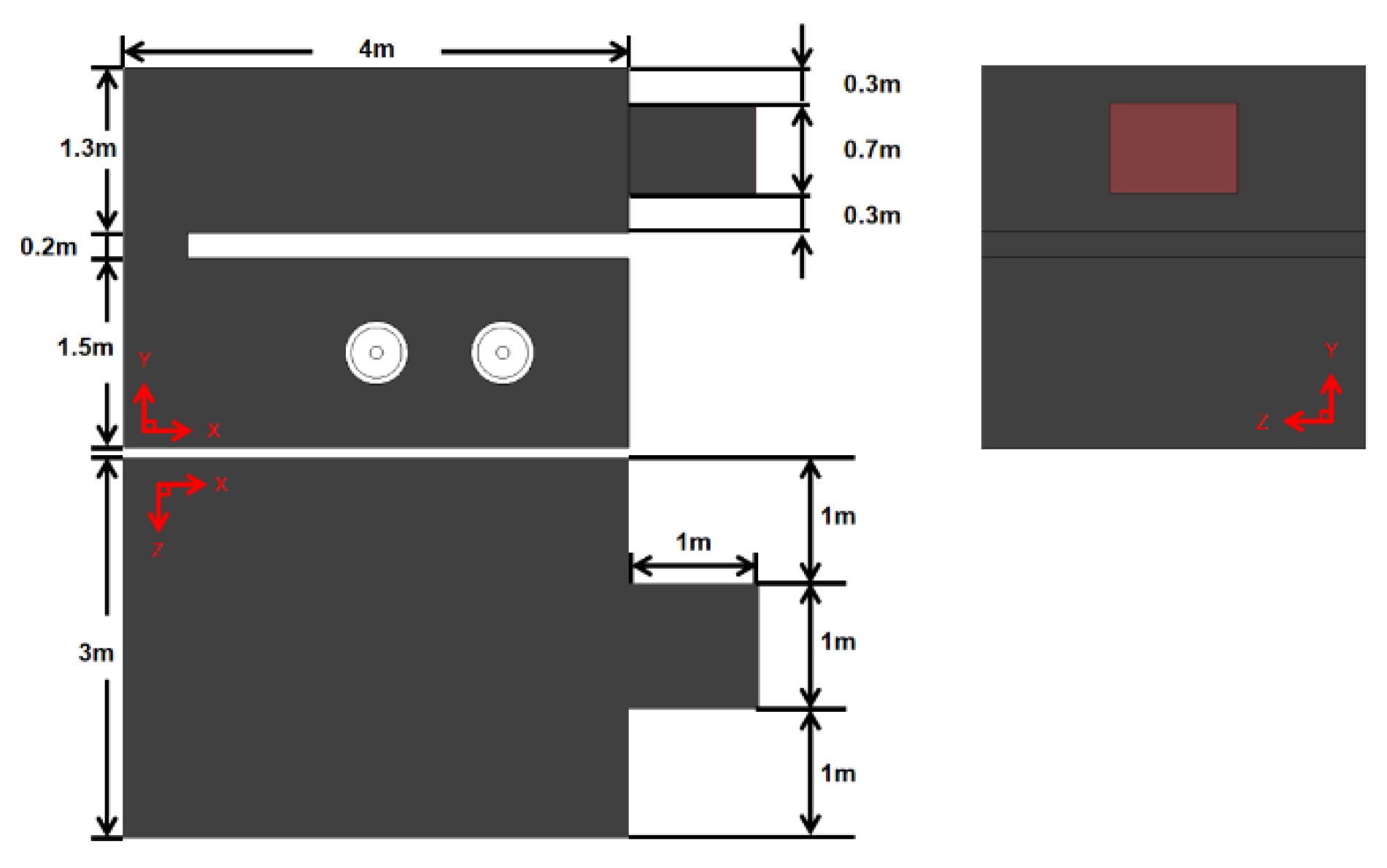
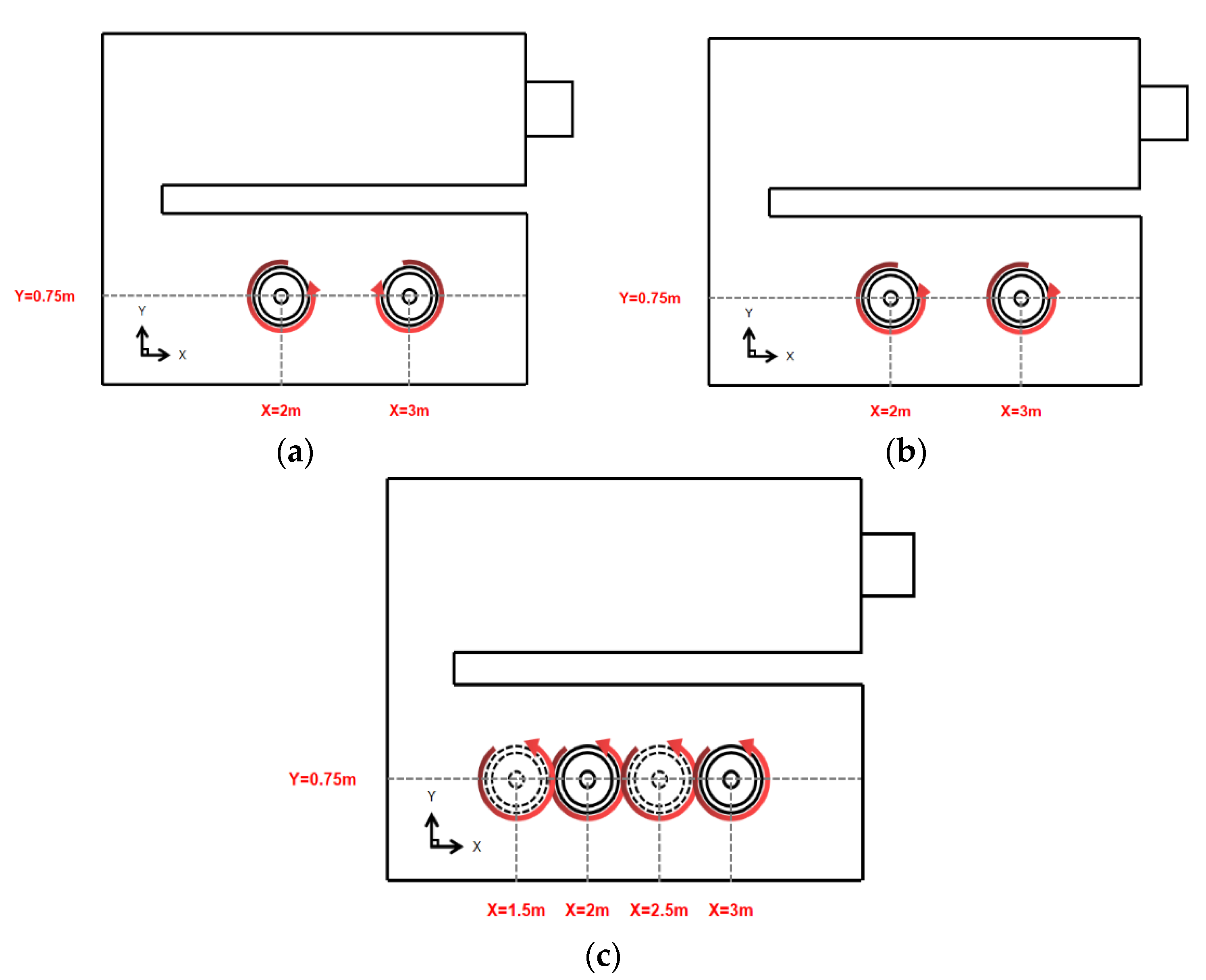
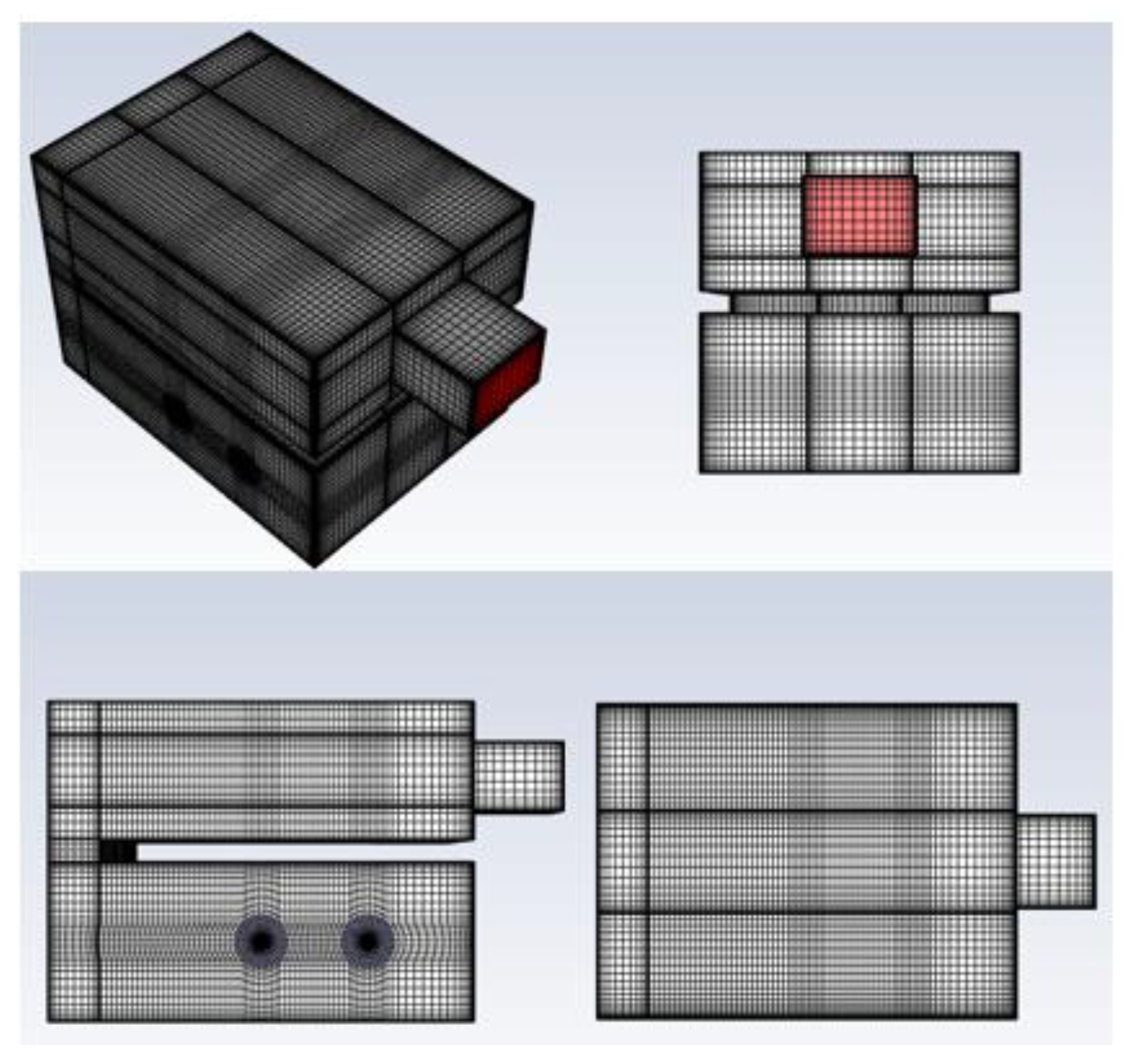
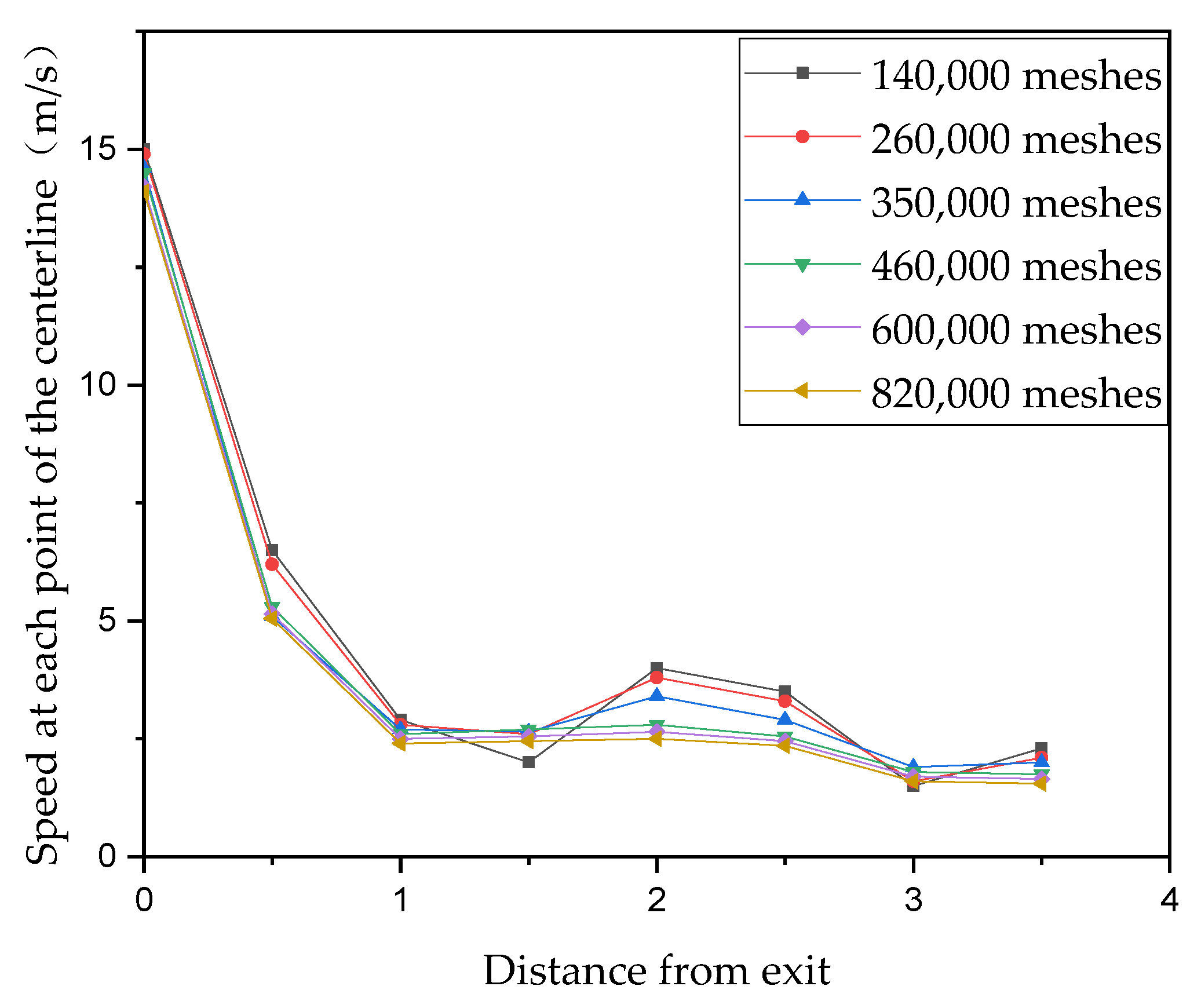
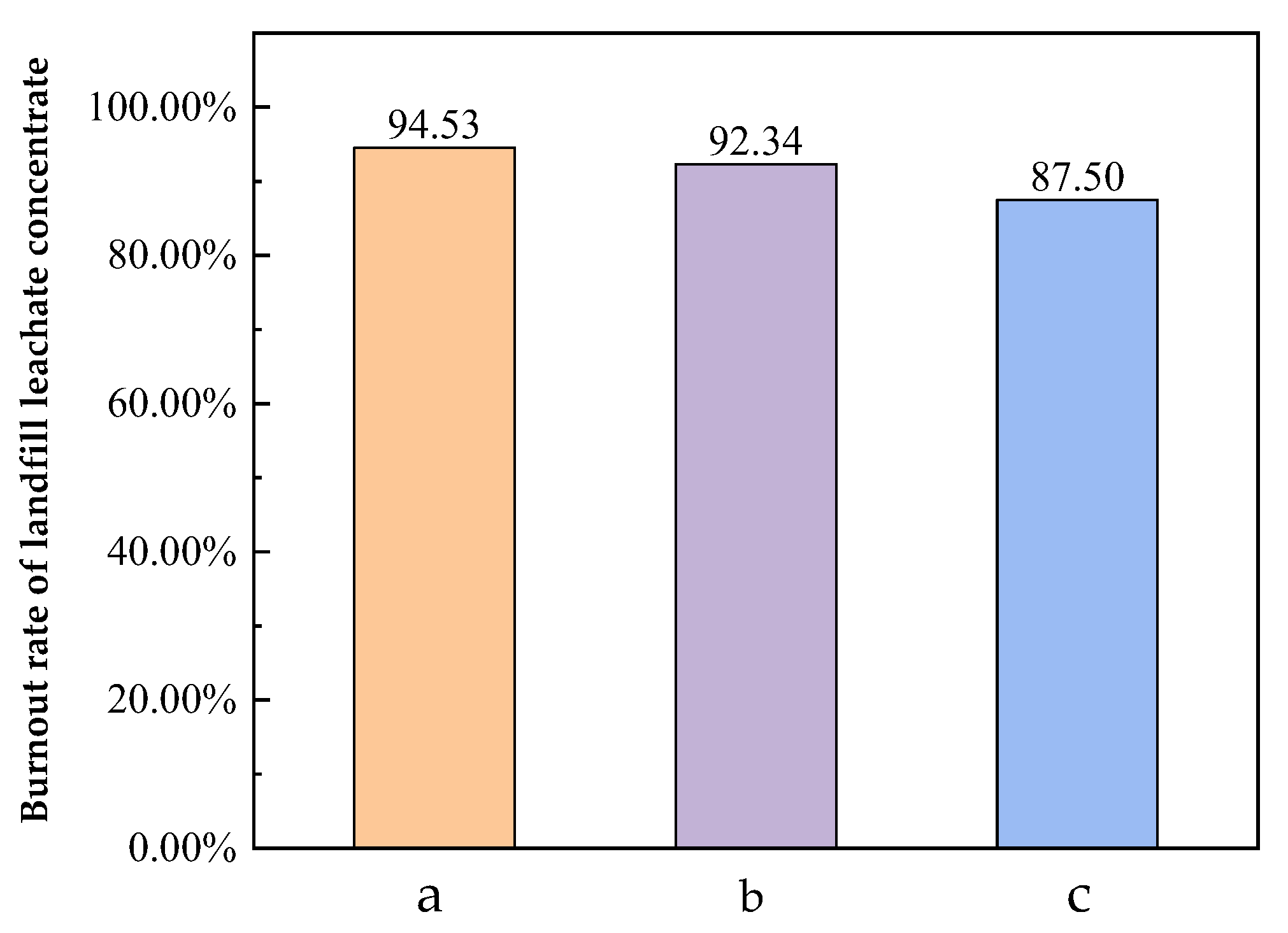
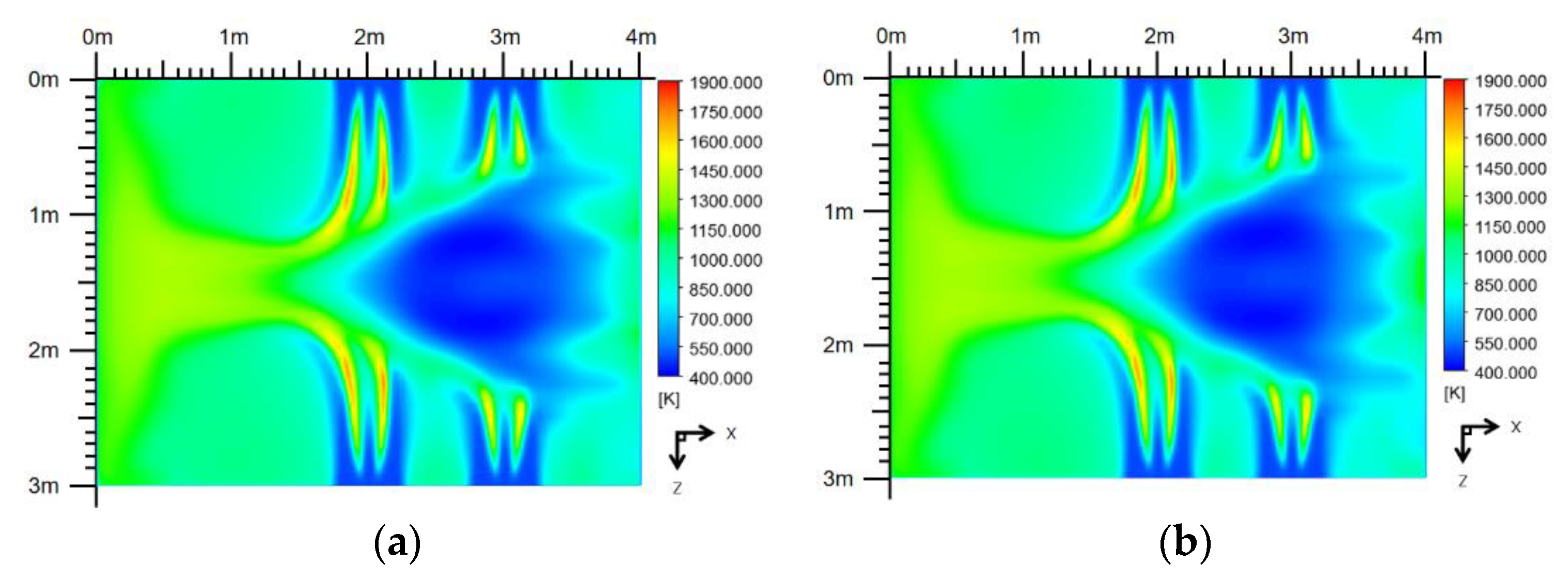
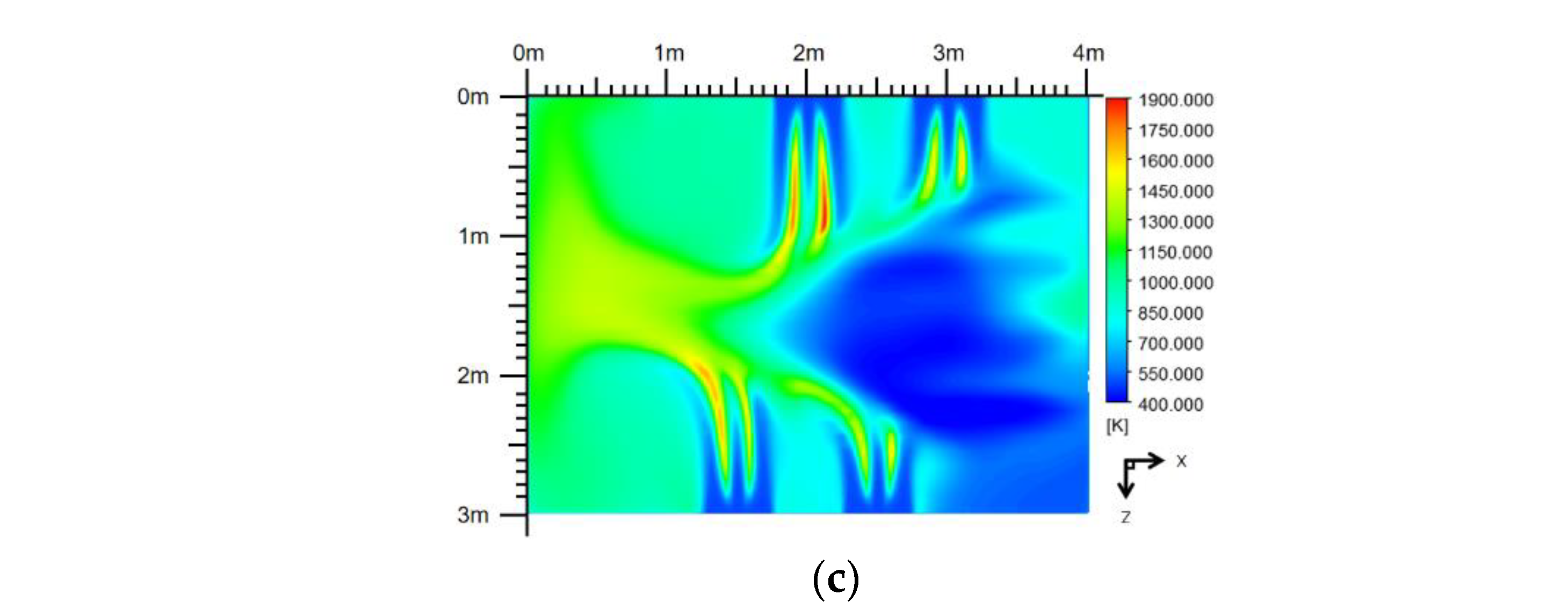
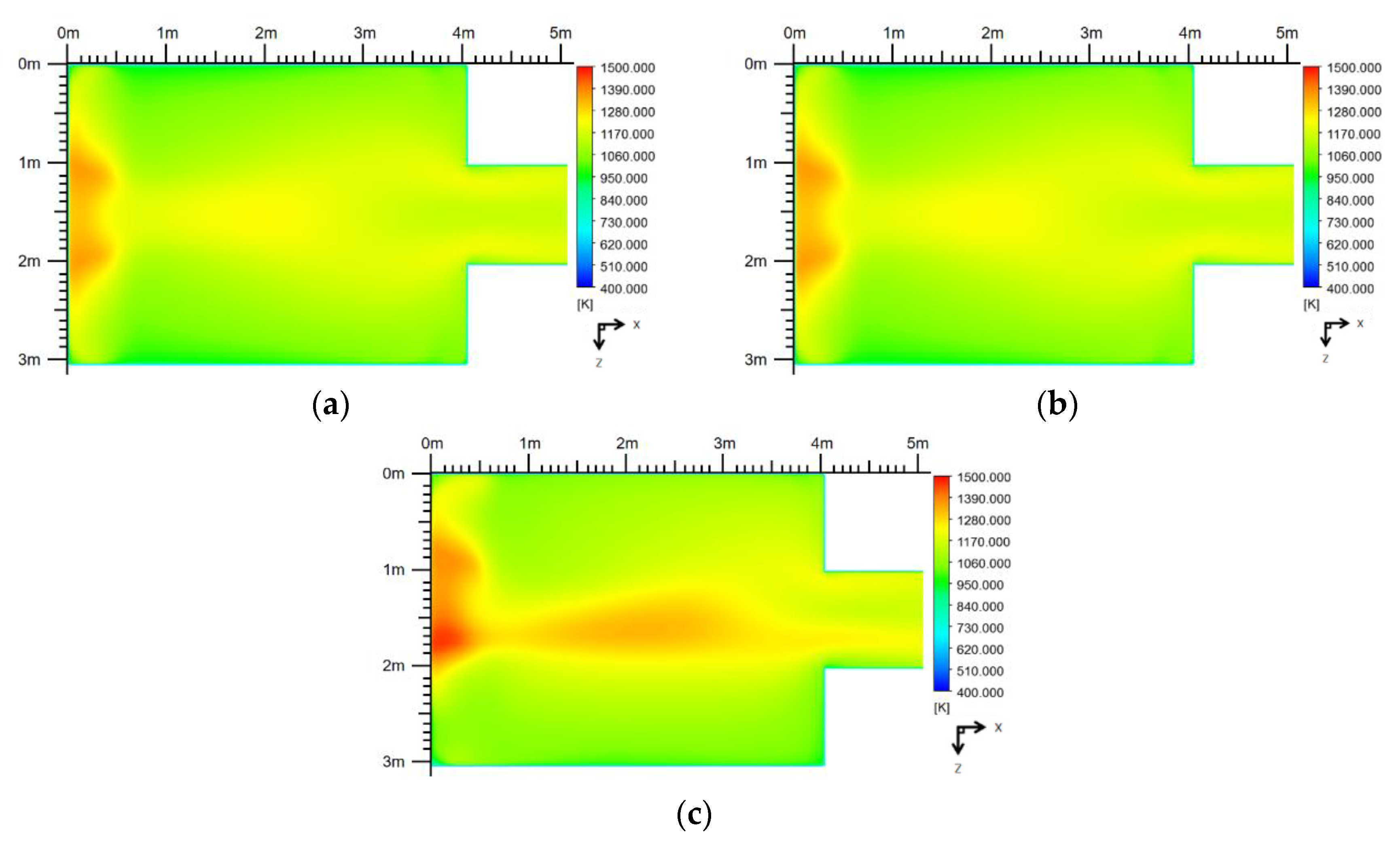
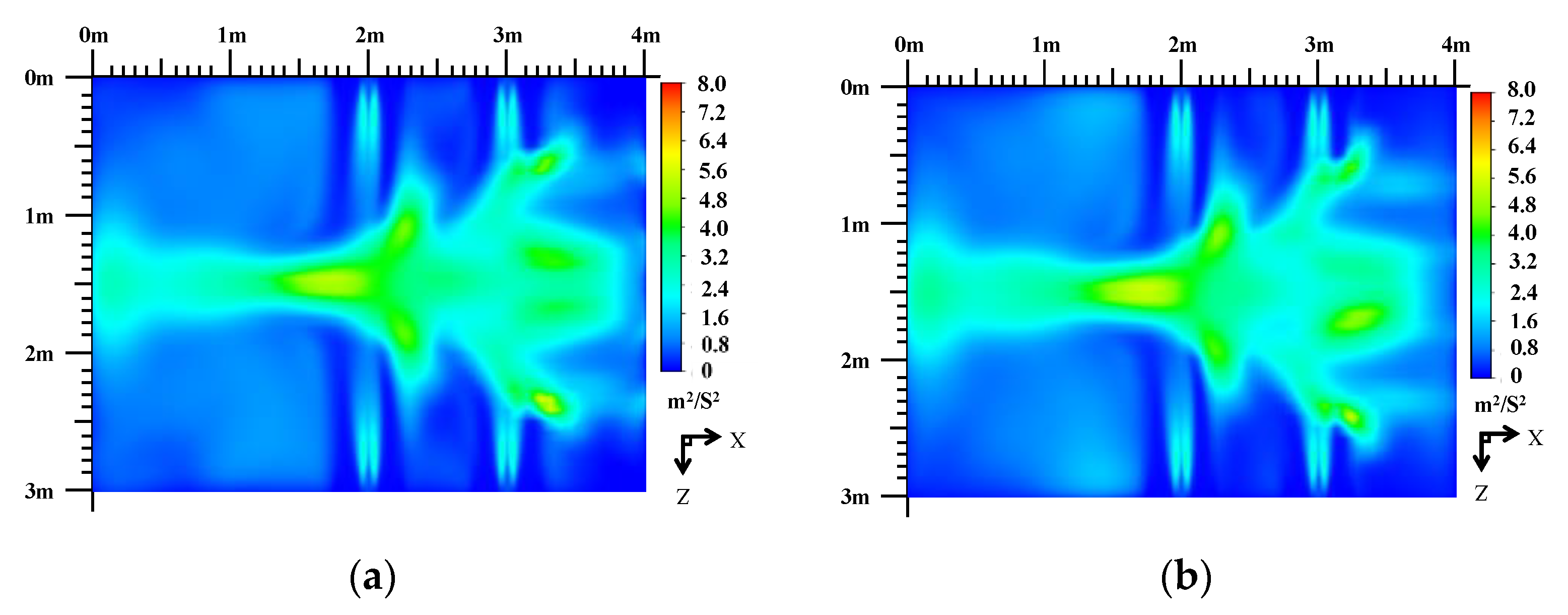
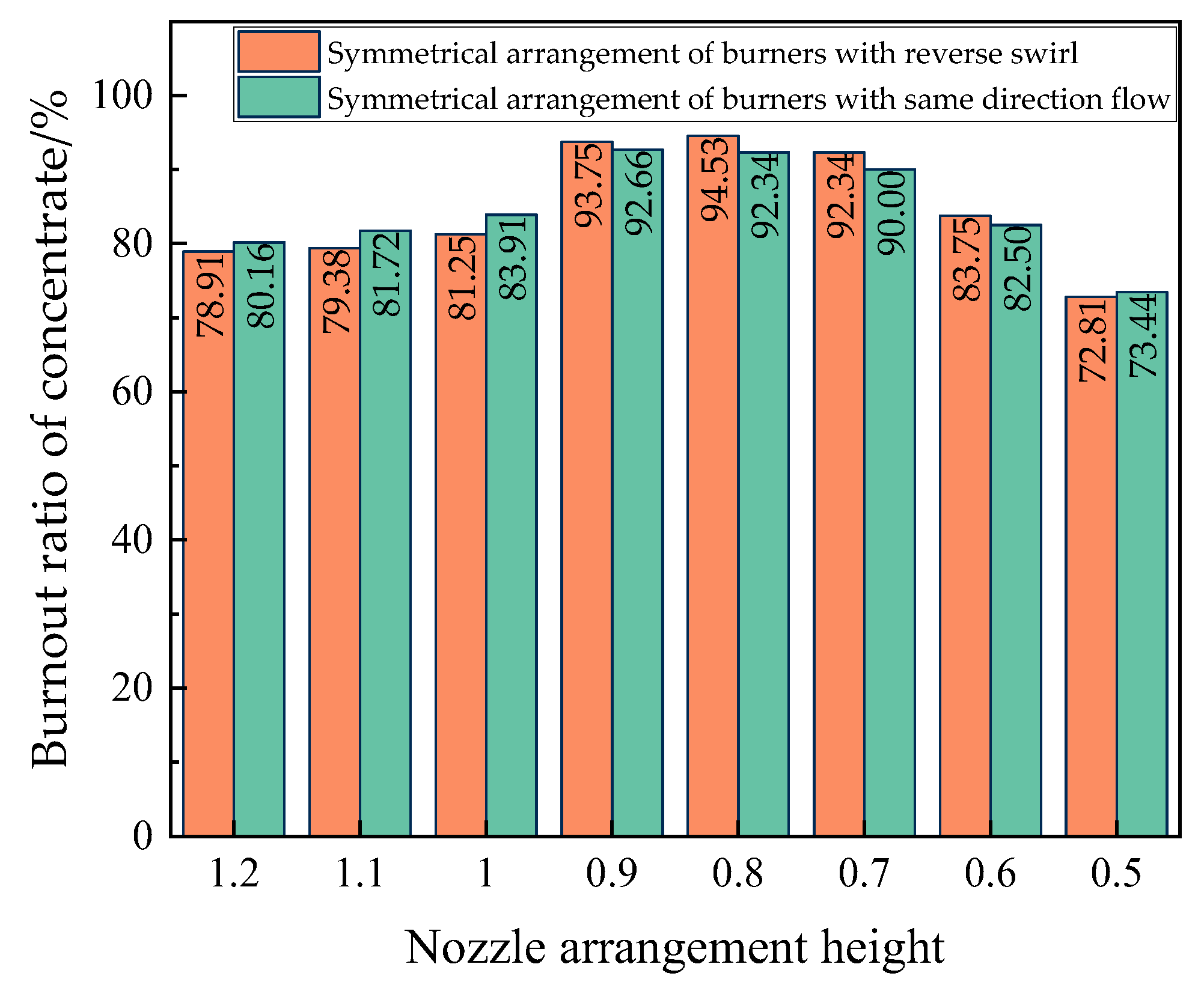


| Flow Field | Item | Unit | Design Condition | |
|---|---|---|---|---|
| Gas phase | Air | N2 volume fraction | % | 79 |
| O2 volume fraction | % | 21 | ||
| Combustion-supporting biogas | CH4 volume fraction | % | 60 | |
| CO2 volume fraction | % | 40 | ||
| Burner swirl air inlet velocity | Axial speed | m/s | 2 | |
| Tangential velocity | m/s | 1 | ||
| Burner direct flow air inlet velocity | Inlet speed | m/s | 5 | |
| Burner combustion-supporting biogas inlet speed | Axial speed | m/s | 8 | |
| Tangential velocity | m/s | 5 | ||
| Liquid phase | Calorific value | kJ/kg | 3652.6 | |
| Moisture content (mass fraction) | % | 76.25 | ||
| Nozzle form | Solid cone | |||
| Spray direction | Perpendicular to the wall and facing the furnace | |||
| The average particle size | um | 150 | ||
| Jet velocity | m/s | 18 | ||
| Single-nozzle flow | kg/s | 0.139 | ||
| Burner Layout | Symmetrical Arrangement of Burners with Reverse Swirl | Symmetrical Arrangement of Burners with Same Direction Flow | Burner-Staggered Arrangement with Same Direction Flow | |
|---|---|---|---|---|
| Item | ||||
| Residence time/s | 2.18 | 2.45 | 1.64 | |
| Outlet flue gas temperature/K | 1152.69 | 1153.20 | 1157.87 | |
| Symmetrical Arrangement of Burners with Reverse Swirl | ||||||||
| Nozzle arrangement heights/m | 1.2 | 1.1 | 1 | 0.9 | 0.8 | 0.7 | 0.6 | 0.5 |
| Residence time/s | 2.12 | 2.27 | 2.45 | 2.26 | 2.18 | 2.08 | 2.75 | 2.73 |
| Burnout ratio of droplets | 78.91% | 79.38% | 81.25% | 93.75% | 94.53% | 92.34% | 83.75% | 72.81% |
| Outlet flue gas temperature/K | 1150.25 | 1154.47 | 1157.87 | 1151.58 | 1152.69 | 1158.4 | 1155.94 | 1155.35 |
| Symmetrical Arrangement of Burners with Same Direction Flow | ||||||||
| Nozzle arrangement heights/m | 1.2 | 1.1 | 1 | 0.9 | 0.8 | 0.7 | 0.6 | 0.5 |
| Residence time/s | 2.62 | 2.33 | 2.37 | 2.85 | 2.45 | 2.64 | 2.78 | 2.79 |
| Burnout ratio of droplets | 80.16% | 81.72% | 83.91% | 92.66% | 92.34% | 90% | 82.5% | 73.44% |
| Outlet flue gas temperature/K | 1152.57 | 1156.58 | 1158.35 | 1150.42 | 1151.2 | 1157.44 | 1154.68 | 1157.68 |
Publisher’s Note: MDPI stays neutral with regard to jurisdictional claims in published maps and institutional affiliations. |
© 2022 by the authors. Licensee MDPI, Basel, Switzerland. This article is an open access article distributed under the terms and conditions of the Creative Commons Attribution (CC BY) license (https://creativecommons.org/licenses/by/4.0/).
Share and Cite
Wu, W.; Liu, J.; Guo, S.; Zeng, Z.; Cui, G.; Yang, Z. Optimization Research on Burner Arrangement of Landfill Leachate Concentrate Incinerator Based on “3T+E” Principle. Energies 2022, 15, 5855. https://doi.org/10.3390/en15165855
Wu W, Liu J, Guo S, Zeng Z, Cui G, Yang Z. Optimization Research on Burner Arrangement of Landfill Leachate Concentrate Incinerator Based on “3T+E” Principle. Energies. 2022; 15(16):5855. https://doi.org/10.3390/en15165855
Chicago/Turabian StyleWu, Wangsong, Jiajin Liu, Shuya Guo, Zhukai Zeng, Guangyao Cui, and Zhongqing Yang. 2022. "Optimization Research on Burner Arrangement of Landfill Leachate Concentrate Incinerator Based on “3T+E” Principle" Energies 15, no. 16: 5855. https://doi.org/10.3390/en15165855




